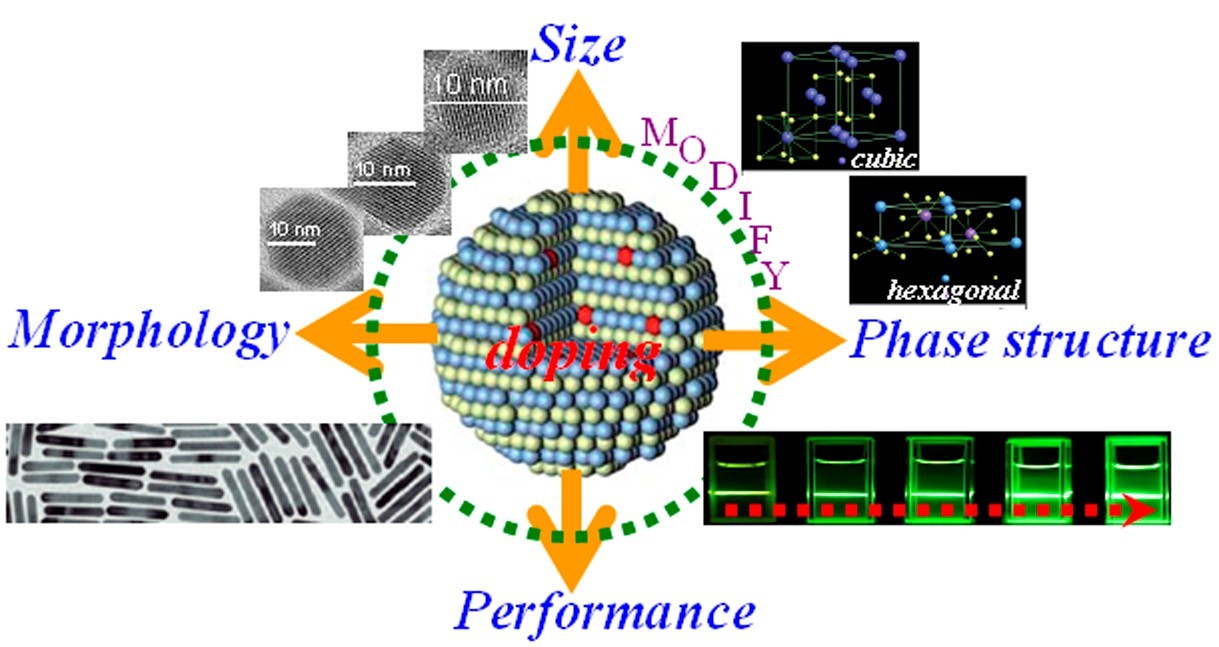
Impurity doping was recently found to have significant influence on nucleation and growth of functional nanocrystals (NCs), and provides a fundamental approach to modify the crystallographic phase, size, morphology, as well as properties of nanomaterials.
Prof. WANG Yuansheng and his co-workers at Fujian Institute of Research on the Structure of Matter, Chinese Academy of Sciences have devoted great endeavors to investigate impurity doping behaviors and their impact on microstructures and performance of lanthanide (Ln3+) NCs, and lots of exciting discoveries have been explored.
For instance, they evidenced for the first time that doping Ln3+ in alkaline-earth fluoride (MF2) NCs allowed products with uneven size and shape to be easily converted into monodisperse nanospheres with ultra-small sizes, and proposed a novel “transient electric dipole” mechanism to control nucleation and growth of NCs (J. Am. Chem. Soc., 2010, 132, 9976).
They demonstrated that doping alkaline-earth into LnF3 induced phase transition of hexagonal LnF3 into cubic Ln0.8M0.2F2.8 solid solutions, and subsequently resulted in 15 times intensified upconversion (UC) emission (Chem. Commun., 2011, 47, 2601).
They reported Ti4+ dopant-induced NaYF4 phase transition from cubic-to-hexagonal at lower synthesizing temperature (down to 1300C), and revealed the key role of Ti4+ ions, i.e., acting as the agglomerators for cubic NaYF4 to accelerate its low-temperature phase transition (Chem. Commun., 2011, 47, 5801).
They found that the addition of Gd3+ into NaYbF4 NCs prompted phase conversion from cubic to hexagonal, reduced mean size of hexagonal NCs, and helped to realize their multi-functionality, i.e., tunable down- and up-conversion emissions as well as paramagnetism (J. Mater. Chem., 2011, 21, 6186).
They demonstrated that adopting the pre-formed cubic phase MF2 NCs as seeds, the doping Cl- ions would be easily incorporated into the host to replace F- ones and subsequently induce the formation of tetragonal phase MFCl NCs (Chem. Commun., 2011, 47, 11083).
In addition, Prof. WANG’s group also explored the possibility to modify the distribution of Ln3+ activators in nano-host. For example, they recently realized the dual-modal emissions of Ln3+ by cutting adverse energy transfer between Ln3+ ions separated in the core and shell respectively, such as Yb/Tm: BaF2@Nd: SrF2 active-core/active-shell nanocubes (J. Mater. Chem., 2012, 22, 2632) as well as Er: NaGdF4@Ho: NaGdF4 NCs (Chem. Commun., 2012, 48, 5898). They revealed Ln3+ clusters for the first time by designing and synthesizing novel Na3Zr(Hf)7 host and observed single-band UC emission (Chem. Commun., 2012, 48, 10630). They also realized the control of Ln3+ clustering degree by modifying the size of CaF2-YbF3 disordered solid-solution NCs and observed abnormal size-dependent UC luminescence (Nanotechnology, 2013, 24, 085708).
It is believed that this novel impurity-doping strategy has a great potential in controllable syntheses and performance optimization for some technologically important nanomaterials. Recently, Prof. WANG and his co-workers published a feature article (selected as “hot paper”) summarizing the related abundant progresses reported in recent years to facilitate the development of this research field (Nanoscale, DOI: 10.1039/C3NR00368J, 2013).

Schematic illustration of doping-induced modification of phase structures, sizes, shapes as well as performances of functional nanomaterials (Image by Prof. WANG Yuansheng's group)
CONTACT:
Prof. WANG Yuansheng
Fujian Institute of Research on the Structure of Matter
Chinese Academy of Sciences
E-Mail: yswang@fjirsm.ac.cn

86-10-68597521 (day)
86-10-68597289 (night)

52 Sanlihe Rd., Xicheng District,
Beijing, China (100864)

